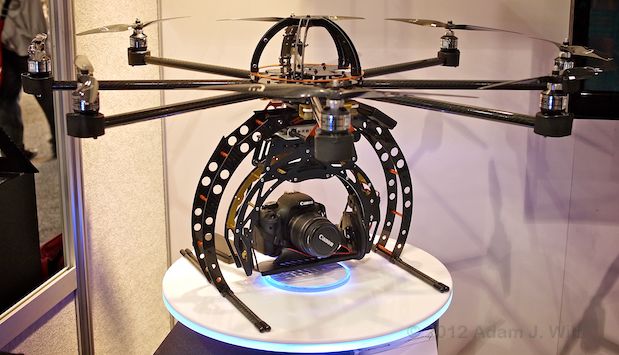Unmanned Aerial Vehicles for Video capture. A Bad Good Idea?
A new gadget category is born this year at NAB2012: Unmanned Aerial Vehicles used for photo and video capture. Will it stand the test of time?
Picture from coverage by Adam Wilt at PROVIDEO COALITION:

Obvious questions that immediately come to mind:
- What is the life expectancy of an UAV? Unless it’s controlled by a trained RC guy, my guess is that it will crash within minutes of use.
- Insurance costs, anybody? Beyond destruction of valuable hardware, there is also a risk in injury for persons. Will even you get coverage?
More problems
- Vibrations can make photo and video capture unusable. Your UAV needs proper dampening and resonance cancellation features. I fear that cheaper UAVs don’t have such niceties. DYI solutions are not for amateurs, unless you have a structural engineering grade.
- In addition to controlling your UAV, you will need to remotely control your camera (zoom, aperture, …), so you probably need two people to operate it.
Aero Quartet Advice
Since our business is to repair corrupt video footage, we are seeing an increasing number of cases coming from UAVs users. Here is our advice about how to minimize risks and costs:
- Use cheap cameras. Image quality will likely be limited by vibrations and by your RC skills, rather than by camera. Crashes will be less painful.
- Use strong tape to prevent camera doors from opening. Battery, SD card can be ejected under a violent acceleration and jeopardize the take.
- We can always recover corrupt footage due to a “hard landing”, but the last few seconds cannot be repaired because they have not yet been written to the persistent memory card.
We have also covered “Destructive or High-Risk Video Capture” in a previous blog post.
Conclusion
I have no doubt that UAVs will become very common in the next few years, not just for video capture, but for many other activities. Today, this is still an emerging technology that is difficult to master, that presents some risks, and doesn’t have a legal framework. It’s not ready for prime-time, but as it opens amazing new possibilities, I’m convinced within a few years it will become a standard practice, just like use of camera cranes or steadycam today.

